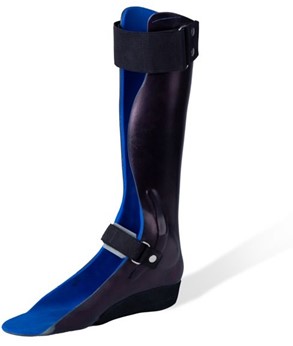A nurse is caring for a client who has right-sided paralysis following a cerebrovascular accident. Which of the following prescriptions should the nurse anticipate to prevent a plantar flexion contracture of the affected extremity?
Sequential compression device
Abduction splint.
Ankle-foot orthotic.
Continuous passive motion machine.
The Correct Answer is C
An ankle-foot orthotic can help prevent a plantar flexion contracture of the affected extremity in a client who has right-sided paralysis following a cerebrovascular accident. This device can help maintain the foot and ankle in a neutral position and prevent the development of a contracture.
a. A sequential compression device is used to prevent deep vein thrombosis and is not specifically designed to prevent contractures.
b. An abduction splint is used to maintain the hip in a neutral position and is not specifically designed to prevent contractures of the foot and ankle.
d. A continuous passive motion machine is used to promote joint mobility and is not specifically designed to prevent contractures of the foot and ankle.

Nursing Test Bank
Naxlex Comprehensive Predictor Exams
Related Questions
Correct Answer is A
Explanation
When checking a client's blood pressure, the nurse should use a cuff with a width that is about 60% of the client's arm circumference. This will help to ensure that the cuff fits properly and provides an accurate reading.
Options b, c, and d are not correct. The cuff should be applied over the client's brachial artery, which is located in the antecubital fossa. The client should sit with their arm resting at the level of their heart, not above it. The pressure on the client's arm should be released at a rate of 2 to 3 mm per second, not 5 to 6 mm per second.

Correct Answer is ["A","B","C","D"]
Explanation
When planning care for a client who has a prescription for extremity restraints on both wrists, the nurse should assess the client's skin temperature and color before applying the restraints to ensure that there is no circulation impairment. The nurse should also ensure that the client's bed is in the lowest position to prevent falls. The restraints should be secured to allow three fingers to slide under them to prevent injury and ensure proper circulation. Bony prominences should be padded before applying the restraints to prevent pressure injuries.
Option e is incorrect because attaching the client's restraints to the bed rail can cause injury if the bed rail is moved or adjusted.

Whether you are a student looking to ace your exams or a practicing nurse seeking to enhance your expertise , our nursing education contents will empower you with the confidence and competence to make a difference in the lives of patients and become a respected leader in the healthcare field.
Visit Naxlex, invest in your future and unlock endless possibilities with our unparalleled nursing education contents today
Report Wrong Answer on the Current Question
Do you disagree with the answer? If yes, what is your expected answer? Explain.
Kindly be descriptive with the issue you are facing.
